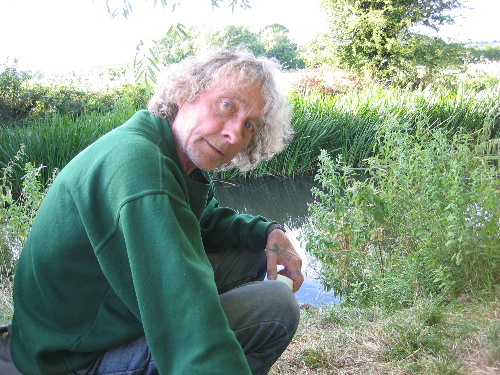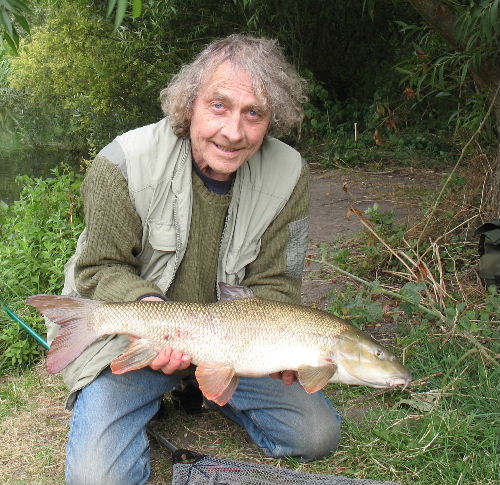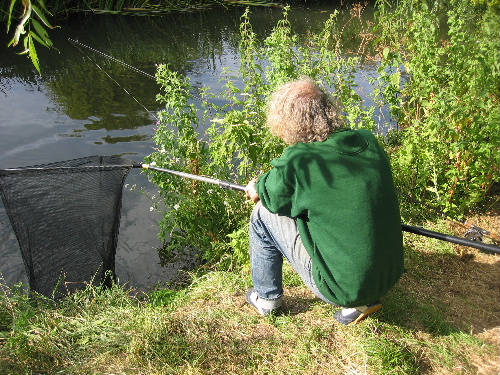A Rig For All Seasons by Fred Crouch
When reaching my chosen swim I’m normally carrying two rod-rests, one rod, landing net, seat, bait and a small shoulder bag containing food and drink, a reel, scales and weigh sling. All bits and pieces are in my pockets. I do not limit what I take to reduce weight but simply because it is all I need.
My simple rig has never changed and comprises a sliding clip swivel to attach a feeder or small bomb, a stop swivel and a hook. I have never felt the need to use any additional attachment other than a bait – dropper.
I have never fished with more than one rod and as that is not based on some kind of morality I will explain the reason. Once I have selected a swim I feed it lightly and intermittently for up to a couple of hours before fishing if I cannot see the bottom. If the water is clear I don’t introduce a hook-bait until I spot fish and they begin to respond in a positive manner. When I do consider the time is right I will lower a bait in and from that moment on I spend virtually every passing second with my gaze fixed to the rod tip. There is no way whatsoever that I could divide my attention between two rods as concentrating on one it is far too important because of what it tells me.
Any movement of the tip can help build an understanding of just what is happening on the river bed. It will indicate when small fish are interfering with the bait, when barbel ‘leaning’ on the line or accidentally clipping the line with a fin. These signs are to me vital in determining how I need to react.
Slight erratic movements of the rod tip suggest the presence of small fish species or maybe crayfish and that tells me that barbel aren’t down there so I retrieve my rig and have cup of tea. I don’t want a dace or any other tiddler dashing around the swim on the end of my line just when I’m trying to put the barbel at ease. I should emphasise my loose feed is always as close to the bank as I can sensibly justify and this can be as little as a few inches.
The next type of indication is when the rod top is pulled round rapidly but just as quickly springs back. This happens when the line gets caught temporarily on a barbel’s fin. It is not good because the fish has very sensitive touch receptors on the leading edges of its fins. The pull is so fast because of the fish’s sudden alarm reaction. Of course there are occasions when the line slides over the fin right down to the hook resulting in an accidental foul – hooking.
Another movement is when the tip goes slowly round but hesitates or stops altogether. If a barbel ‘leans’ on the line it will not be aware while the contact is solely with the body scales and will carry on feeding as if nothing undue is happening unless, as I have just described, the line touches a fin. I deal with both problems if they do occur by lengthening the tail a few inches and positioning my hook bait nearer to the top end of the loose feed to reduce the risk.
The whole point is that I will be aware when barbel are visiting the swim and thus make any fine adjustments necessary to increase my chances of catching. Once they are feeding in a contented way catching them becomes much more likely and once my rod is flying round every now and then I can afford to remove my gaze from it when I need to and give my ears a little exercise by virtue of the sweet sound of the ratchet on my centre pin.
My angling approach and style has its roots in years past when it was described as the gentle art but I certainly do not make comparisons with then and now and say one method is wrong and another is right. If an angler’s quest is fulfilled by any particular legitimate method then I am all for it and far be it for me to criticise it. That’s why, despite suggestions that my approach is something from the dark ages I have never been tempted to change it, and the reason is it that works today just brilliantly as it has always worked.
A few paragraphs back I said I would explain why I fish as close to the bank as possible. I would never even contemplate just chucking a bait into the middle of the river and waiting for a fish to stumble across it. If I take food to the river I consider my highly developed brain entitles me to decide where the fish will eat it. That will always be where it is most suitable to me not them. It is a simple philosophy but it succeeds many more times than it fails.
There is however another less obvious reason why fishing very close in offers the pinnacle of excitement. A fish grabbing a bait on a leger rig out in midstream will certainly bend the rod over but nothing will match the sudden violent acceleration a barbel will display when hooked in a place close the bank that it desperately wants to leave. It never fails to amaze as the rod tip whizzes round and in the time it takes to grab the butt the reel is already screaming.
I’ll do a bit on the range of baits I have used over more than fifty years and some that I have never used when Steve can find me a space.
FRED CROUCH March 2010







Leave a Reply